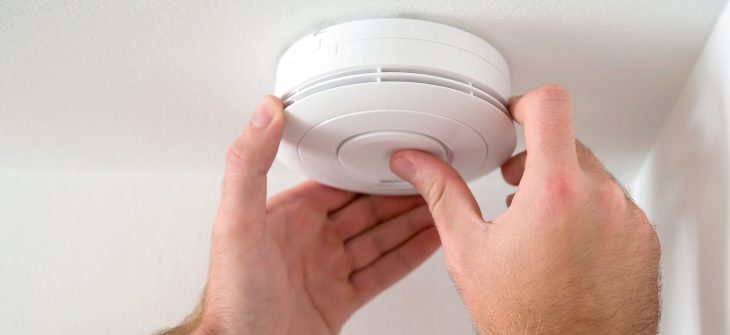One of the most important pieces of safety equipment in your house is your fire alarm. Even though it is relatively easy and inexpensive to practice, fire safety is a commonly neglected household necessity. In fact, 60% of house fire deaths happen in homes without working smoke alarms. Thirty-eight percent of these deaths occur as the result of fires in homes where there are no smoke alarms at all. By contrast, in those homes that do have working smoke alarms, the risk of fire-related death is cut in half. It seems so simple!
When it comes to outdated or nonworking fire alarms, more often than not people fail to understand and navigate their own technology. But in the event of a crisis, when every single second will matter, it is essential that you know that all of your equipment will be functioning properly! This blog outlines a few important safety steps that can bring you peace of mind by helping you make sure the fire alarm in your home is working and up-to-date.
Know Your Equipment
Before you can get too far in taking care of your fire safety protocol, you need to know what kind of equipment you have in your home. For example, there are two main types of smoke detectors: battery-powered and hardwired. Battery-powered smoke detectors, obviously, require batteries to function. These are generally autonomous sensors that sound an alarm when they detect smoke. Unfortunately, this means that residents on one side of the house might not be alerted to a fire on the other side. Our smoke detectors generally do require batteries, we just replace them for the customer under warranty at no charge when they get low.
Hardwired devices, on the other hand, are connected to your home’s electricity, but they typically also have batteries as backup power in case of a power outage. When smoke detectors are part of your electrical wiring, they are also connected to each other and can work together to alert you to the presence of smoke or fire.
Whatever smoke detectors you have, it is important that you familiarize yourself with the manufacturer’s instructions and have a basic understanding of how the device or system in your home works. The instruction manual will also tell you exactly what to do in order to ensure the equipment is operating properly.
Test Frequently
Unfortunately, there are many variables that can impact a smoke detector’s ability to function correctly and consistently, from a dead battery to a faulty sensor. Because a fire requires a quick evacuation, it is critical that you test your smoke detectors and fire alarms before you really need them. And because fires can happen at any time for any number of reasons, the need for testing is ongoing. According to experts, you should be testing your smoke alarm at least once per month — especially if it’s solely battery-powered. While you should always check the manufacturer’s information to be sure, in order to test, most smoke detectors require you to press and hold a “test” button. A loud, sharp alarm or siren should sound; if little or no sound comes out, that is a good indication that it’s time to replace the batteries.
Always make sure to have someone else helping you with smoke detector testing, like the professionals at SafeTouch Security, as they can tell you whether or not the alarm can be heard in different areas of the house. Ideally, you will have a whole system of interconnected smoke detectors whose sensors trigger a fire alarm that can be heard easily throughout the property. Additionally, the National Fire Protection Association (NFPA) recommends a working smoke detector in every bedroom, as most fires occur in the middle of the night when people are sleeping. As a rule, it’s better to have too many smoke detectors than too few. They could be the difference between life and death!
Change the Batteries
No matter how many or what kind of smoke detectors you have, it is so important that you change the batteries regularly. Many of these devices will conveniently alert you when the batteries are low — often with that annoying, repeated chirp that is basically impossible to ignore! With or without the shrill reminder, though, experts recommend changing the batteries in your smoke detectors at least once a year, especially when they’re low. A weak test sound may be an indicator that the batteries are low and should be replaced.
Replace Your Equipment
Even with frequent testing and diligent upkeep, no fire alarm or smoke detector is built to last forever. That is why the NFPA recommends that you have your smoke detectors replaced every ten years, no matter what. Luckily, at SafeTouch we will take care of replacing your smoke alarm batteries as covered by your warranty. If you’re not sure exactly how old a device is, the date of manufacture is typically located on the back of the alarm. No matter how long it’s been, if the test sound just isn’t working even after you’ve inserted fresh batteries, you should have the equipment replaced as soon as possible!
Upgrade Your System
At SafeTouch, we know how much you value peace of mind when it comes to your family and your home. We value your peace of mind too. That is one reason our residential smoke detectors do not require batteries or the regular upkeep outlined above. As part of a fully integrated security system, our sensors activate all fire alarms to ensure everyone in the building is aware of the need to evacuate. The alarms also alert authorities, making sure emergency responders are on the way. Time is of the essence, and the sooner we are able to get someone out to your site, the better we are able to minimize the damage caused by the fire.
We monitor your security needs so you can focus more of your attention on the people and places you’re trying to keep safe. You should spend time enjoying the life you’ve built; let us worry about protecting it. All our SafePlans come with excellent customer service, a guaranteed 45-second (or less) response, a lifetime warranty, and much more! Contact us today to schedule an onsite inspection and a quote, at no cost and with no obligation.

